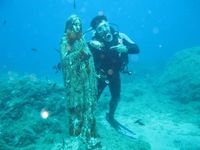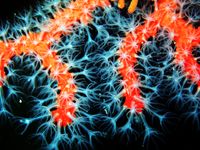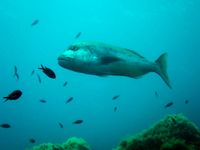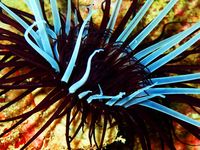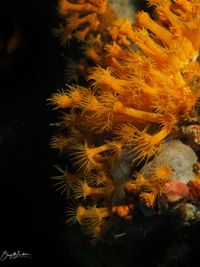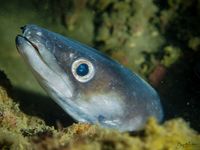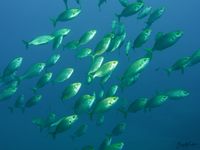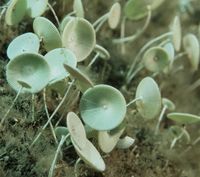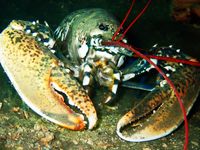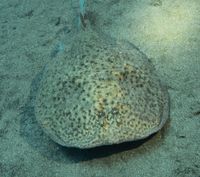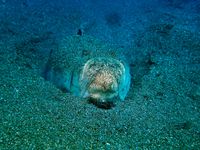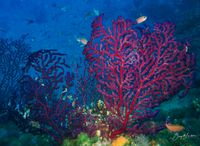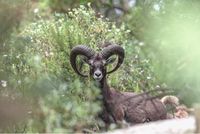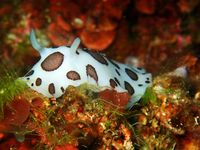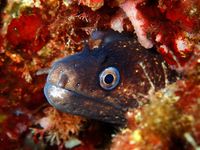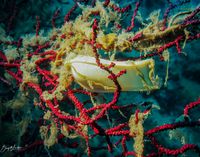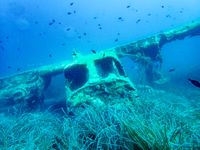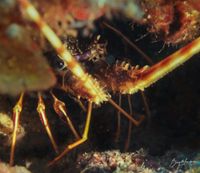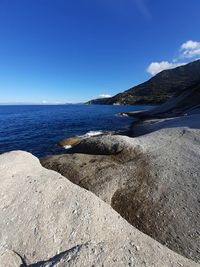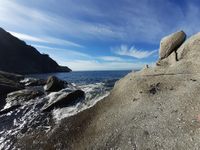Dive spots
Highlights in the south of Elba
Here you will find a description of a few of our marvelous dive sites. Anyway, the best way to experience the great places is on site.
Triglia (Scoglio della Triglia)
Just outside the gulf of Marina di Campo there is a large promontory that drops underwater to a depth of about 20 meters. This dive site is famous for a statue of the Madonna at a depth of 15 meters, which was placed there by fishermen in 1970. The statue is a great starting point for a dive heading south. If you hold the wall to the left, you reach an impressive group of rocks at a depth of around 30 meters. Here you will find an enormous variety of fish (groupers, dentex, octopuses, damselfish, shrimp, snails, etc.) and a magnificent flora. The rocks can be circumnavigated to complete the dive at the starting point.
Fonza inside
Directly in front of Capo Fonza a tongue of land closes the Gulf of Lacona. A small shoal protrudes slightly from the water near the coast. The eastern face of this rock reaches a depth of up to 40 meters, where a small grotto can be found. This diving area is characterized by countless crevices, canyons and channels and is covered with beautiful red corals, anemones and yellow gorgonians. Numerous moray eels, conger, groupers and crustaceans can be found.
Fonza outside
One of the highlights of Elba's south is located slightly upstream of Capo Fonza. From a depth of approx. 45 meters, a scarpe slope rises in the south-eastern part of the dive site, the end of which protrudes almost below the water surface. This rugged rock face is home to a variety of animals and good observers will discover countless scorpion fishes, moray eels, crayfishes and even a lobster. On the outside, dentex keep circling and eagle rays fly by. In the eastern part, at a depth of around 20 meters, there is a plateau where a number of groupers cavort and sometimes large schools of barracudas can be observed. While surfacing in the shallow area, it is worth keeping an eye out for hermit crabs or spider crabs.
La Corbella
A little off the Stella coast we find the island of La Corbella. A speciose dive site that has something to offer for every diver. Thanks to its relative simplicity, the northern part is particularly suitable for beginners (15 - 20m) and delights with its biological diversity (moray eels, groupers, octopuses). The areas south-west and south-east of the island are a little more challenging. From a depth of 30 - 35 meters you will find magical gorgonian forests in purple, where you are guaranteed to come across catshark eggs between May and October. Regardless of the season, there are dentexes, groupers, moray eels, barracudas, eagle rays and the experienced eye can spot a conger or a lobster. This place is also excellent for snorkeling! Always a pleasure for everyone.
Capo Stella
The dive usually starts in a small lagoon, from which you dive in a southerly direction. After a short while you come to a rock formation that drops down to a depth of 30 meters. In these rocks there are numerous starfish and nudibranchs to discover, with a trained eye also an octopus or scorpion fish. Experienced divers can explore a cave at this spot, the entrance is about 12 meters depth. Afterwards it is worth it looking back at the rocks above the cave! The porous rock releases the air bubbles to the surface from numerous openings. It's like being in a whirlpool!
Yellow wall
About 50 meters from the coast north of Capo Stella, this enchanting diving area hides an unexpected small rock at a depth of 14 meters, surrounded by extensive fields of sea grass and sandy areas. Its west side is covered with golden-yellow cluster anemones. The boulder, which drops down to 40 meters, protrudes at its highest point about 7 meters below the water surface. Its distinctive feature is the deep gap that runs through the whole chunk. There is never a lack of fish here.
Morcone Reef
The varied Morcone Reef is right on our doorstep. The wall, which descends towards the mainland and reaches a depth of 35 meters, has numerous surprises to offer in the noumerous small caves and holes. On top of the drop-off, a wide plateau, octopuses and many other shy sea creatures hide in labyrinthine furrows and crevices. An extremely varied dive site, where there is no shortage of groupers, moray eels and barracudas, and a curious conger sometimes watches us from its hiding place.
Gemini
These two small rocky twins are located west of the coast of Capo Calamita near Capoliveri. The small but nice dive site slopes slowly along a rocky bottom. Between 10 and 17 meters you will find interesting cavities, small caves and natural arches and canyons, in which numerous exciting creatures live.
La Focacciola / Punta della Focacciola
South of the Gemini Islands, a modest rock juts out of the water. His modesty is deceptive: both inexperienced and experienced photographers will find valuable surprises here and will never be disappointed. The varied slope can be explored at a maximum depth of 20 meters in a calm and composed way. Its walls, animated by the fascinating play of light, are characterized by innumerable canyons, crevices and caves, which are animated by groupers, dreamfishes, octopuses, moray eels and countless nudibranchs. At a depth of about 10 meters you will find a small vegetated cave arch, through which you can dive if you are careful.
Monkey rock (Isolotto Corbelli)
Around a spectacular rock formation, called Isolotto Corbelli, there is a veritable labyrinth of canyons. With the best visibility, diving through the georgous underwater mountain landscape is a real pleasure. Swarms of barracudas lives there, numerous moray eels, and the attentive diver is often unexpectedly treated to a short conger «tête-à-tête». Lovers of details are also guaranteed to get their money's worth here.
Jacques Mayol
The dive site is named after the famous apnea diver, under whose house on the cliff we find the anchor point. Underwater there is a small wall that extends to a depth of 35 meters. It's worth descending this wall slowly to see the many starfish, nudibranchs and flatworms. Also crayfishs or congers can be discovered at this place. Right next to the wall there is a large sandy area where hermit crabs or sand eels can be observed. If you have a good eye, you might even come across a cleverly camouflaged stargazer or a torpedo ray.
Punta Rossa
An easy dive site with the possibility of encountering very rare underwater creatures. The anchor is droped on a sandy area a few meters away in front of a rock formation. There is a possibility of encountering stingrays or torpedo rays on the sandy area. Once you have reached the rock formation, follow it to a maximum depth of 25 meters. Small groupers or scorpion fish are often encountered here. Large schools of damselfishs and dreamfishs are faithful companions at this dive site. If you have a good eye, you can even discover a stargazer.
Remaiolo
The small rocky island of Remaiolo, with its turtle shape, stretches not far to the west of Punta dei Ripalti. Southwest of its ridge, the varied wall falls to a depth of up to 45 meters, overgrown with countless beautiful red gorgonians. As you go down, the wall gets steeper and steeper, its caves are full of life and many surprises. Groupers, moray eels, barracudas and many small sea creatures can be found around the island. This dive site is also ideal for a leisurely snorkeling trip.
Ripalti / Grottone
The dive site can be divided into two areas with the dive starting nicely in the middle. If you dive from the boat in a southerly direction, there are two small cliffs, which have everything to offer - from nudibranchs to scorpion fish and lobsters. It is important to look away from the steep wall into the blue water from time to time so that you don't miss the barracudas and dentex. Even Sunfishs have been spotted at this dive site. If you dive north from the boat towards the coast, you will reach two small cave arches via large, washed out boulders. Between the rocks you can always find small groupers, scorpionfish and moray eels. With good visibility a breathtaking underwater landscape. The journey alone is definitely worth a visit. If you look closely at the rocky coast, you will sooner or later discover one of the wild sheep that live here or even a pack of these graceful mountain climbers. The so-called moufflons or muffles are often confused with goats.
picture on the left (Mufflon): Gianfranco Bedoschi
Picchi di Pablo
This unforgettable dive site, rich in fish and color, is located between the Gulf of Porto Azzurro and Punta Calamita. Picchi (= peaks) owes its name to two rocky peaks that rest over a breathtaking cliff. It is undoubtedly one of the most fascinating diving areas on the island. This impressive vertical, which drops to a depth of 42 meters, is populated by shrimps, moray eels, crabs, nudibranchs, mussels, scorpionfish, forkbeards and many more. On the bottom, towards the coast, there is a small cave, on the ceiling of which it is not uncommon to see crayfishs or a lobster. Covered with corals, anemones and gorgonians, this unique cliff gleams in garish greens, yellows and purples, captivating every inch with its diversity of life and incomparable beauty.
Capo Calvo
The dive at Capo Calvo starts from a small bay with water depths of 5-8 meters. A sandy, slightly sloping terrain leads to some boulders in which moray eels and scorpionfishs or an octopus are hiding. From a depth of 30 meters you dive into a veritable forest of red gorgonians. Large schools of barracudas, dentex and the occasional sunfish can often be seen in this part. Parallel to the coast you dive in the shallow water along a few boulders towards the starting point and can end the dive in the sheltered bay.
Relitto Aereo
This easy dive site always offers an exciting experience for both, our beginners and advanced divers. It is particularly suitable as an alternative in cloudy weather conditions on the south side. The relict of the small sports aircraft lies at a depth of only 14-17m in a sheltered bay not far south-east of Porto Azzurro (just before Punta Nera). This is a Britten-Norman BA-2 A6 Islander, registration number I-BADE, which was operated by TRANSAVIA on the day of the accident (06/27/1980). One of the two motors fell off and is lying in the sand. The encrusted hull is wonderfully animated by sponges, nudibranches and other bryozoans. Small and large scorpionfishs, groupers and maybe even a moray eel or an octopus can be found in its hull. Colorful schools of damselfishs, dreamfishs and - if you're lucky - barracudas swim around the wreck.
Punta delle Cannelle (Sugarloaf)
The Punta delle Cannelle is located on the north coast of the Golfo di Porto Azzurro and offers diving depths between 15m and 45m. This dive site, which we rarely visit, surprises again and again with its variety of flora and fauna and an extraordinary topography. At a depth of around 30 meters, the wall splits diagonally. The cliff is overgrown with red gorgonians, yellow cluster anemones and is populated by moray eels, groupers, crustaceans and octopuses.
Sant’ Andrea
The 150 m wide, flat sandy beach of Sant'Andrea is always worth a visit. The small town itself lies steeply on a slope and in the immediate vicinity you will find spectacular rock formations not only above the water. The sea here is mostly clearas crystal. The entrance to the dive site is a few meters west along a naturally formed footpath over the granite rocks smoothed by the water. At this part, there is a fascinating underwater world to discover. It offers the ideal habitat for many species of fish, which are found here in large numbers. Shoals of tiny damselfish, an electric blue color, swarm through the lush green of the seagrass. Groupers scurry by, little scorpionfishs hide in the crevices and there is much more to discover.
After an extensive dive you can sunbathe and warm up on the huge rock slabs in a smooth way.
Pomonte (Wreck of Elviscot)
The Elviscot can be dived or "snorkeled" from both the stone beach and the boat. The approximately 25m long and 500 tonne wreck of the cargo ship Elviscot, which sank in 1972, is located at a depth of 12 - 13 meters on the southwest side of the Ogliera cliff opposite the village of Pomonte. The Italian cargo ship left Naples for Marseille on January 10, 1972, but hit the Ogliera rock and sank. The stern lying on the right side, part of the command bridge and a side part can still be found on the sandy seabed. The engine room and engine system can be seen through the chimney. The light-flooded metal wreck offers many species of cave fish (moray eels, groupers, octopuses) safe protection and a perfect habitat at any time of the year.
